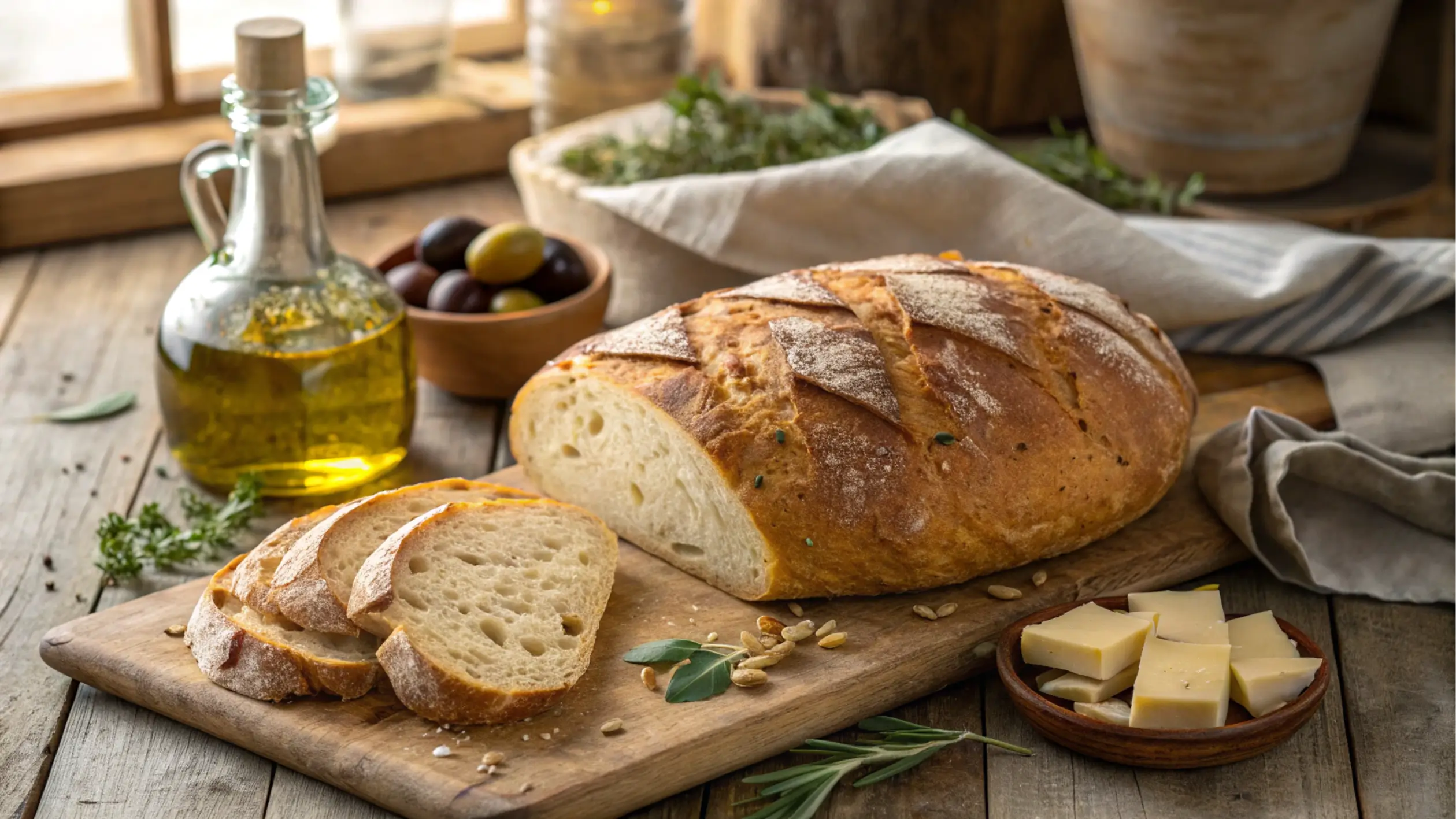Written by Sarah Miller
Artisan Italian bread is more than just a basic food—it represents history, showcases skilled craftsmanship, and is a delicious addition to countless meals.In this guide, we’ll explore the essence of artisan Italian bread, focusing on its history, unique qualities, and the methods used to make authentic loaves. Furthermore, from understanding what makes it special to learning how to bake and enjoy it, this article is your go-to resource for everything about Italian bread.
Let’s begin by exploring the basics and understanding why this bread is a unique delicacy in Italian cuisine.
What is Artisan Italian Bread?
Artisan Italian bread is a handcrafted surprise, outstanding in its rustic look, chewy texture, and intense flavor. Unlike industrially produced loaves, artisan bread celebrates simplicity with a short list of herbal elements—flour, water, salt, and yeast. Its appeal lies in the clever method of crafting each loaf, often using time-venerated strategies handed down through generations.
History and Cultural Significance in Italy
Bread has been a crucial part of Italian culture for centuries, with records of its importance tracing back to ancient Rome. Moreover, artisan bread reflects the Italian ethos of “la dolce vita,” or living life to its fullest, savoring the simple pleasures. Traditionally baked in communal ovens, it was—and nevertheless is—a cornerstone of family meals, celebrations, and everyday life.
Why Artisan Methods Matter
Artisan breadmaking is as much art as it’s miles a science. The gradual fermentation system develops complicated flavors, even as the cautious crafting ensures the proper stability of crust and crumb. These traditional methods no longer most effectively produce advanced taste and texture but additionally keep the authenticity that’s lost in cutting-edge, business baking.
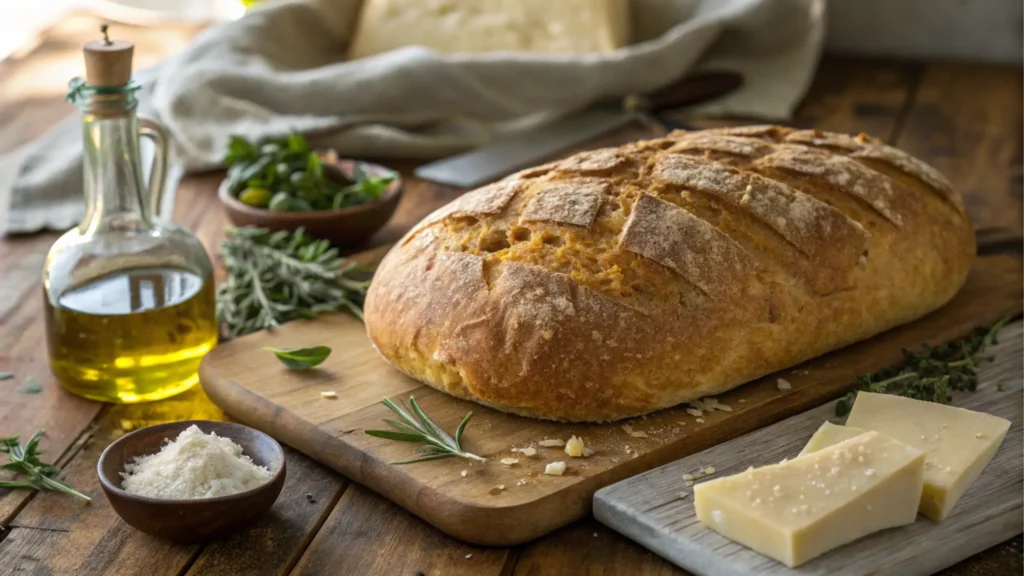
Characteristics of Artisan Italian Bread
Defining Features: Crust, Texture, and Taste
Three trends stand out regarding this bread: a crusty exterior, a soft crumb, and a flavor that tells a story. The golden-brown crust crackles below your touch, giving way to a tender, chewy interior. This texture results from an ideal balance of hydration and fermentation, making each chunk a pleasure. Unlike bland business bread, artisan loaves boast complicated flavors that evolved through slow fermentation, regularly followed by guidelines of nuttiness and diffused tang.
Difference Between Artisan and Commercial Bread
What sets artisan Italian bread apart, other than its industrial opposite numbers is its authenticity. Commercial bread frequently sacrifices exceptional for velocity, the usage of preservatives, components, and brief-upward thrust techniques. Artisan bread, however, relies on traditional methods, minimum elements, and endurance. Each loaf is a hard work of affection, reflecting the baker’s dedication to keeping Italy’s wealthy culinary traditions.
The Role of Simplicity in Ingredients
The hallmark of artisan bread lies in its simplicity. In essence, flour, water, yeast, and salt combine to create something great. Unlike commercial options, there are no synthetic enhancers or shortcuts—simply sincere, healthy ingredients. Consequently, this focus on quality over quantity ensures that artisan Italian bread delivers a superior eating experience every time.
| Nutrient | Amount (Per 100g) |
|---|---|
| Calories | 260 kcal |
| Protein | 8g |
| Carbohydrates | 50g |
| Fat | 1.5g |
| Fiber | 2g |
| Sodium | 500mg |
Key Ingredients
Flour: The Foundation of Artisan Bread
Flour is the backbone of artisan Italian bread. Typically, the choice of flour—often high-quality, unbleached wheat—is key to the bread’s texture and taste. For example, Italian flours like “Tipo 00” or “Tipo 1” are popular for their fine texture and protein content. As a result, these flours help create the right balance of stretchiness and softness.
The Importance of Water Quality
It might surprise you, but excellent water can make or damage your bread. Soft, mineral-rich water complements the dough’s fermentation technique, allowing the yeast to work magic. This is why artisan Italian bread made in some regions of Italy has a distinct flavor formed by using the nearby water.
Yeast and Fermentation in Traditional Breadmaking
Yeast is where the magic happens. In most cases, natural yeast or sourdough starters are used in artisan Italian bread, allowing for slow fermentation. As a result, this process creates rich, complex flavors and makes the bread easier to digest. Furthermore, the fermentation process gives each loaf its unique tangy taste.
Salt: Enhancing Flavor
Salt does more than add flavor—it also controls fermentation and strengthens the dough. In conventional Italian recipes, sea salt is frequently used to decorate the bread’s herbal flavor, ensuring every chew of artisan Italian bread is perfectly seasoned.
Internal linking opportunities: While this text specializes in artisan Italian bread, readers who are inquisitive about pairing ideas might find recipes like a Southwest Chicken Salad Guide a pleasing supplement to their bread creations.
Techniques for Making Artisan Italian Bread
Mastering Kneading for Authentic Artisan Italian Bread
Kneading your dough could make all the distinctions when making artisan Italian bread. Traditional kneading involves working the dough by hand and building gluten strands that provide the bread its shape and chewiness. However, the no-knead approach, popularized for its simplicity, is predicated on time instead of attempt. A slow fermentation method develops an equal gluten network, making it ideal for home bakers who choose an arms-off method.
Perfecting Fermentation and Proofing for Italian Bread Flavor
Fermentation is the secret to the bold flavors of Italian bread. The slow upward thrust allows herbal yeast to break down the dough, growing complicated notes and a mild, ethereal crumb. Proofing, the last upward push before baking, is equally vital. During this step, the dough rests and develops its previous shape. Proper proofing guarantees the bread doesn’t collapse during baking and achieves its feature top and texture.
Baking Tips for a Perfect Crust
Achieving the golden, crackling crust of artisan Italian bread requires careful attention during baking. Preheating the oven with a baking stone or metal mimics traditional stone ovens, offering even warmth. Additionally, adding steam during the first couple of minutes of baking maintains the crust soft, permitting the bread to enlarge absolutely before placing.
The Role of Stone Ovens in Authenticity
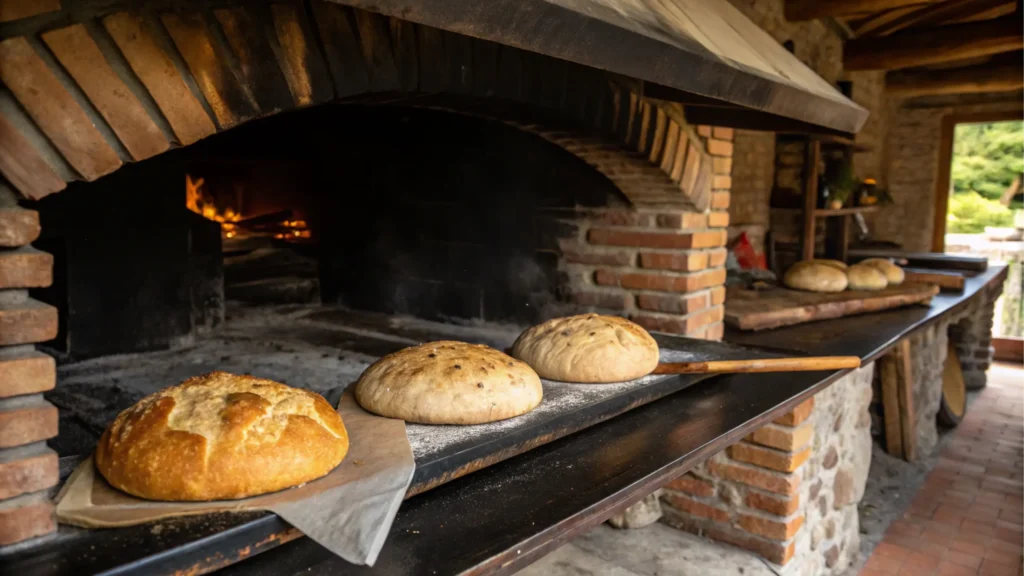
Stone ovens are iconic in Italian baking, presenting a unique taste and texture to the bread. The high, consistent warmth ensures a super crust even as preserving moisture inside. While modern ovens can mirror this impact to a point, the genuine flavor of bread baked in a timber-fired stone oven remains remarkable.
Popular Types of Artisan Italian Bread
Ciabatta: The Iconic Flat Loaf
Ciabatta is one of the most recognizable types of artisan Italian bread. Known for its irregular holes and chewy texture, it’s the go-to bread for making panini sandwiches. Its high-hydration dough offers a mild and ethereal crumb, while its rustic look adds allure to any meal.
Pane Toscano: A Salt-Free Specialty
Hailing from Tuscany, pane Toscano is a fascinating tackle artisan Italian bread. Its absence of salt displays an ancient feud over salt taxes; however, it additionally makes it an excellent companion for flavorful dishes like salumi or rich stews. The bread’s moderate flavor and tender texture make the accompanying meals shine.
Focaccia: The Versatile Flatbread
Focaccia is a canvas for creativity. This bread is typically baked flat and crowned with olive oil, sea salt, and now and again herbs or veggies. Its pillowy texture and rich flavor make it a fave for snacking, dipping, and, simultaneously, as a pizza base.
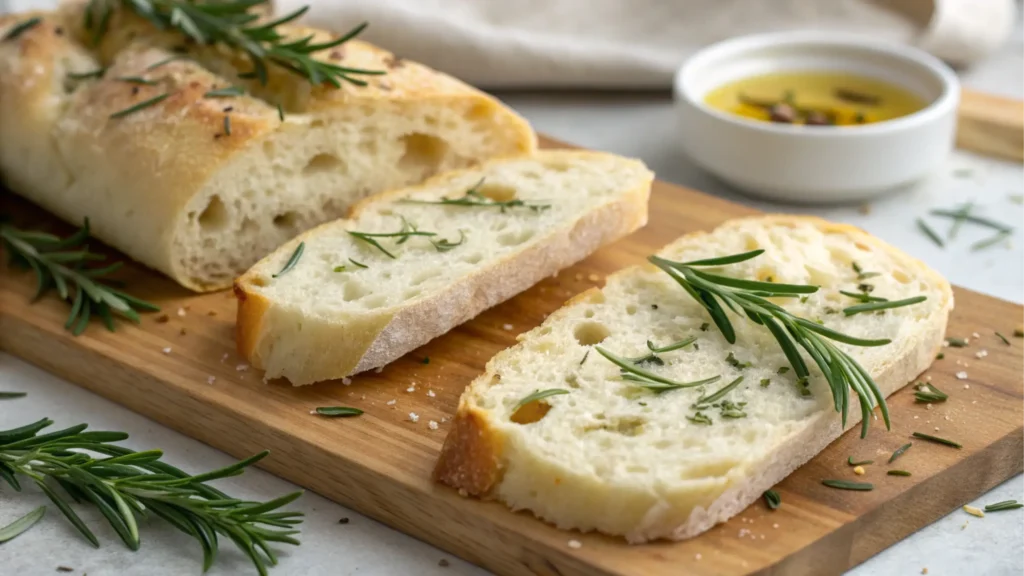
Pane Pugliese: A Southern Italian Delight
From the Puglia location, pane Pugliese is loved for its ambitious taste and rustic look. Its dough is like ciabatta, but it’s fashioned into spherical loaves with a thick crust and smooth indoors. This bread pairs wonderfully with olive oil and clean tomatoes, making it a staple in Southern Italian cuisine.
Linking Opportunity:
While crafting artisan Italian bread, you might also discover other scrumptious recipes for your table. For instance, the Southwest Chicken Salad Guide can be an ideal accompaniment to those Italian loaves.
Pairing and Serving
Traditional Pairings: Cheese, Olive Oil, and Wine
This bread is a natural companion to many traditional Italian flavors. Drizzling more excellent virgin olive oil over a slice or pairing it with elderly cheeses like Parmigiano-Reggiano or Pecorino creates a simple but indulgent appetizer. When paired with a robust Italian wine, like Chianti or Barolo, the bread transforms into an extended culinary enjoyment.
How to Use in Italian Recipes
This bread isn’t only a facet—it’s often an essential ingredient. For instance, focaccia makes a superb pizza crust or sandwich base. At the same time, stale artisan Italian bread is best for panzanella, a traditional bread salad. It’s additionally a staple for soups like ribollita, in which the bread soaks up the rich flavors of the broth.
Creative Modern Uses
Beyond traditional recipes, artisan Italian bread shines in cutting-edge kitchens. For example, you can use ciabatta for gourmet avocado toasts, or make French toast with leftover pane Toscano for a unique twist. Furthermore, the bread’s versatility makes it an extraordinary addition to both sweet and savory dishes.
The Art of Buying
How to Identify True Artisan Bread
Spotting artisan Italian bread at the store or bakery requires a discerning eye. Look for loaves with a rustic, choppy form, a golden crust, and a chewy, ethereal crumb. True artisan bread frequently lacks uniformity because it’s handmade, not mass-produced. It is also essential to check the aspect list—it should be brief and straightforward.
Where to Find Authentic Italian Bread
Authentic artisan Italian bread can be found at local bakeries, farmers’ markets, or forte Italian stores. Many online stores also offer freshly baked loaves that are shipped immediately to your door. Alternatively, for the freshest experience, remember making it at home with delicious ingredients.
Closing Suggestion:
Artisan Italian bread is more than a food; it’s an experience that connects us to the Italian way of life. Whether paired with a hearty stew or used to sop up the ultimate drop of olive oil, this bread enriches every meal.
Frequently Asked Questions
What is Artisan Italian Bread?
Artisan Italian bread refers to handmade loaves made using traditional strategies and simple, exquisite elements like flour, water, salt, and yeast. Moreover, this bread stands out for its rustic look, chewy texture, and rich flavor, which is frequently achieved through slow fermentation. In contrast, commercial bread often relies on shortcuts or additives, while artisan loaves are a complex work of love made with care and dedication.
Is it Just White Bread?
Not at all! While many varieties of artisan Italian bread are made with white flour, they’re a long way from ordinary white bread. For instance, artisan loaves like ciabatta, focaccia, and pane Toscano feature specific textures, flavors, and shapes, making them extraordinary. Additionally, their preparation and baking methods bring out complex notes and a depth of flavor that regular white bread lacks.
What Kind of Bread is Artisan Bread?
Artisan bread is defined by its craftsmanship rather than a particular type. In the case of artisan Italian bread, this includes sorts like ciabatta, pane Pugliese, and pane Toscano. Each loaf is made with care, emphasizing first-rate over quantity. Its cognizance of traditional techniques and simple components is what sets it apart.
What is the Best Italian Bread?
The “exceptional” artisan Italian bread relies upon non-public choice and its meant use. Ciabatta is ideal for sandwiches, focaccia makes a fantastic snack or pizza base, and pane Toscano is suitable for soups and stews. Each bread kind brings its precise attraction to the desk, making each chew special.
Conclusion and Final Thoughts
Artisan Italian bread is more than a staple—it celebrates subculture, pleasantness, and flavor. Each loaf tells a story, reflecting Italy’s rich culinary history and the artistry of its bakers. From the airy crumb of ciabatta to the rustic attraction of pane Pugliese, artisan bread offers plenty of textures and tastes to suit every meal.
Incorporating artisan Italian bread into your daily meals elevates your dining experience. It connects you to the undying art of breadmaking. Whether loved with olive oil, paired with exceptional cheeses, or used in conventional recipes, this bread is a testimony to the splendor of simplicity.
As you discover the world of artisan Italian bread, consider attempting different sorts or even baking your own. The journey from kneading to tasting is as worthwhile as the last loaf. Let this manual inspire you to savor every crumb and share the joy of artisan bread with your loved ones.
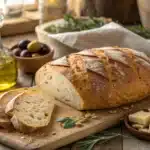
Artisan Italian Bread
Ingredients
Main Ingredients
- 500 g High-quality unbleached wheat flour Preferably 'Tipo 00' or 'Tipo 1' Italian flour
- 350 ml Soft, mineral-rich water Water quality affects fermentation and flavor
- 10 g Sea salt Enhances flavor and controls fermentation
- 5 g Yeast (or sourdough starter) For slow fermentation and complex flavors
Instructions
Preparation
- In a large mixing bowl, combine flour and salt.
- Dissolve yeast in water and add to the flour mixture.
- Mix until a rough dough forms, then knead by hand for 10-15 minutes.
- Cover the bowl with a damp cloth and let it rest for 1 hour.
Fermentation and Proofing
- After the initial rest, stretch and fold the dough in the bowl to develop gluten.
- Cover and let rise for 2-3 hours until doubled in size.
- Shape the dough into a loaf, place it in a proofing basket, and let it proof for another 1-2 hours.
Baking
- Preheat the oven to 220°C (428°F) with a baking stone inside for at least 30 minutes.
- Transfer the dough onto a parchment-lined baking sheet or directly onto the stone.
- Create steam in the oven by adding water to a preheated tray below, then bake for 25-30 minutes until golden brown.
